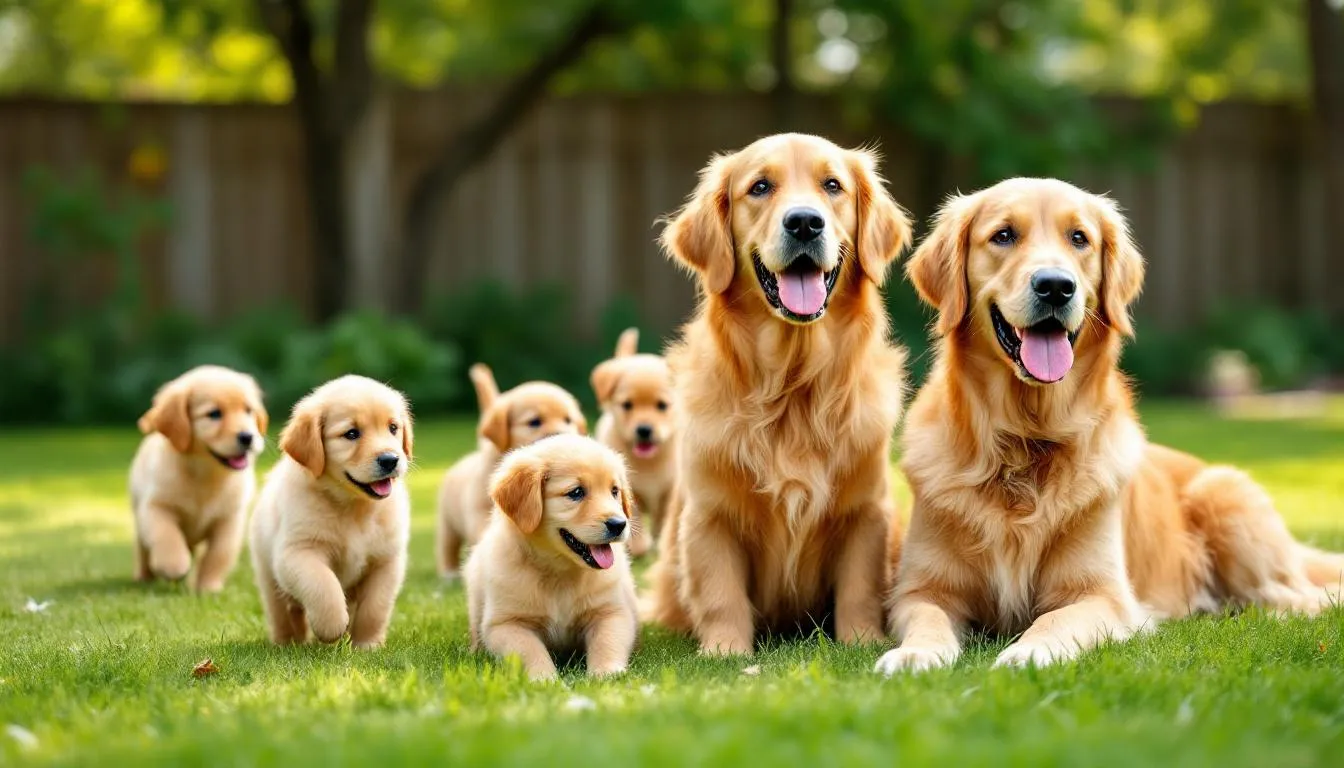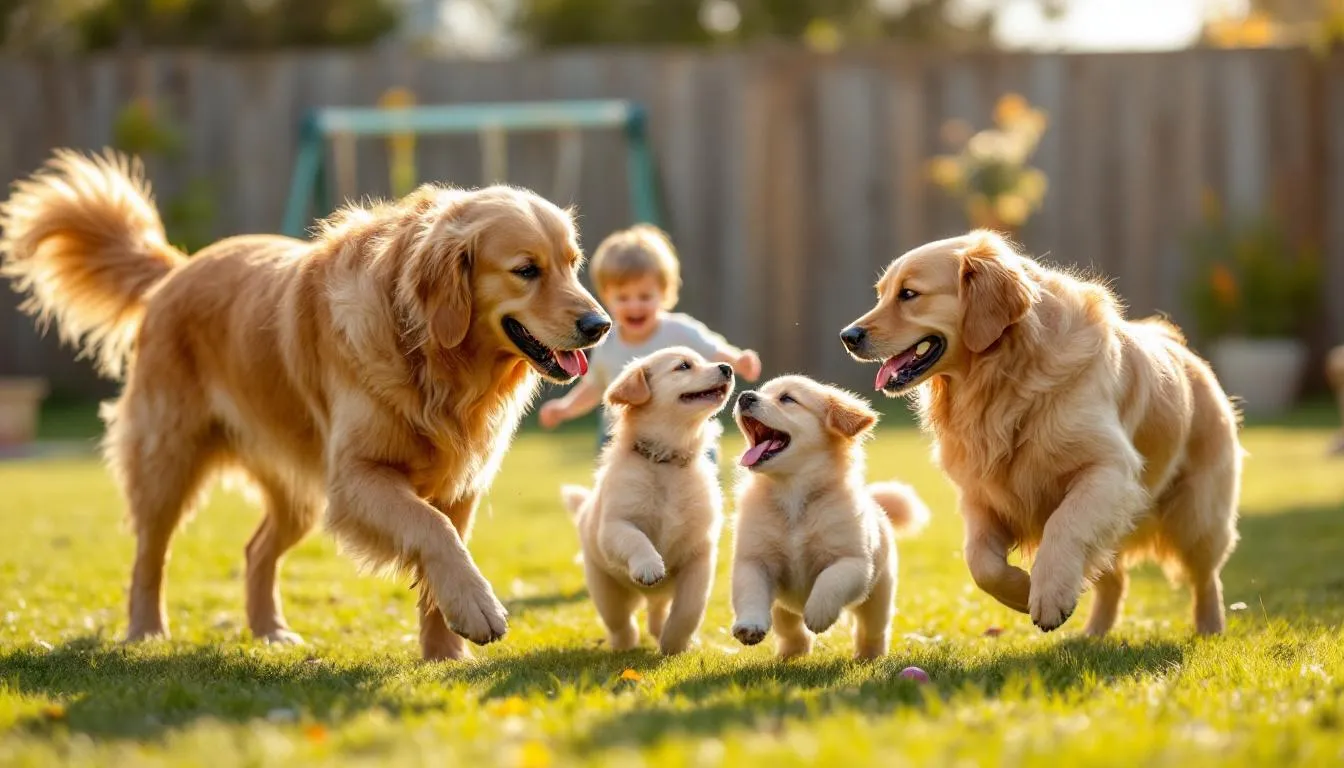Introduction to the Breed
The Golden Retriever is a beloved medium-sized breed that has won the hearts of dog lovers around the world. Instantly recognizable by their luscious golden coat and warm, friendly expression, Golden Retrievers are known for their gentle temperament and unwavering loyalty. The Golden Retriever consistently ranks among the most popular dogs in the United States, thanks to its widespread appeal, high ranking, and suitability as both a family pet and a working dog. Originally developed in Scotland, this breed was designed to be both a skilled working dog and a devoted companion. As members of the Sporting Group, Golden Retrievers excel in a variety of canine sports, including agility, obedience, and field trials, showcasing their intelligence and versatility. Whether you’re looking for a playful family pet or an active partner for outdoor adventures, Golden Retrievers are adaptable dogs that thrive with proper care, attention, and plenty of opportunities to exercise both body and mind.


Key Takeaways
Golden Retrievers are medium-sized sporting dogs weighing 55-75 pounds with distinctive golden double coats
- Golden Retrievers are medium-sized sporting dogs weighing 55-75 pounds with distinctive golden double coats
- They possess exceptional intelligence, gentle temperament, and strong retrieving instincts making them ideal family pets
- The breed requires daily exercise, regular grooming, and consistent training due to their high energy and heavy shedding
- Originally bred in 1860s Scotland by Lord Tweedmouth, they excel as hunting dogs, service animals, and companions
- Generally healthy but prone to hip dysplasia, eye conditions, and heart disease requiring health screenings from reputable breeders
They possess exceptional intelligence, gentle temperament, and strong retrieving instincts making them ideal family pets
The breed requires daily exercise, regular grooming, and consistent training due to their high energy and heavy shedding
Originally bred in 1860s Scotland by Lord Tweedmouth, they excel as hunting dogs, service animals, and companions
Generally healthy but prone to hip dysplasia, eye conditions, and heart disease requiring health screenings from reputable breeders
Golden Retrievers consistently rank among America’s most beloved dog breeds for good reason. Their winning combination of intelligence, loyalty, and gentle nature has made them the third most popular breed according to the American Kennel Club. Whether you’re considering adding a golden retriever to your family or simply want to understand what makes these dogs so special, this comprehensive guide covers every aspect of golden retriever characteristics.
From their distinctive golden coat to their exceptional temperament, golden retrievers possess unique traits that set them apart from other dog breeds. Understanding these characteristics helps you appreciate why they excel as family dogs, service animals, and sporting companions. Let’s explore what makes the golden retriever breed truly remarkable.
Physical Characteristics of Golden Retrievers and Overall Appearance
The golden retriever’s physical characteristics reflect their heritage as skilled water retrievers and bird dogs. Males typically stand 23-24 inches tall and weigh 65-75 pounds, while females measure 21.5-22.5 inches and weigh 55-65 pounds. This medium sized breed strikes an ideal balance between strength and agility.
Their most distinctive feature is the broad head with kind, intelligent eyes and short ears that hang close to the cheeks. The straight muzzle and well-proportioned features give golden retrievers their characteristic friendly expression. Their sturdy build reflects generations of breeding for endurance and retrieving work in the Scottish Highlands.
The golden retriever’s water repellent coat consists of a dense double coat system. The outer coat features longer, water-resistant guard hairs, while the soft undercoat provides insulation in cold water. This water repellant double coat, combined with their muscular build, makes them a strong swimming dog, able to work effectively even in harsh weather conditions.
Coat colors range from pale cream to deep golden red, though the American Kennel Club standards exclude extremely light or dark shades. Regional variations exist: European Golden Retrievers often display lighter English Cream colors, while Canadian lines frequently show richer reddish coats. The feathery tail and longer hair on the chest, legs, and tail add to their elegant appearance.
Temperament and Personality Traits
Golden retriever temperament represents the breed’s greatest asset. These dogs combine gentle friendliness with remarkable intelligence, ranking as the 4th most intelligent dog breed according to canine intelligence studies. Their eager-to-please nature makes them exceptionally responsive to training and human guidance. Golden retrievers excel in obedience training, often achieving high marks in obedience trials and AKC obedience championships. Obedience training is essential for developing well-behaved, socialized Golden Retrievers and helps them reach their full potential.
The breed’s patient and kind demeanor with children has earned them a reputation as outstanding family dogs. However, their size and enthusiastic nature mean they may accidentally knock over small children during play. Early socialization helps channel their natural exuberance appropriately.
Golden retrievers form strong social bonds with family members and demonstrate remarkable adaptability to various living situations. Their friendly, trusting nature means they’re not suitable as guard dogs—most golden retrievers greet strangers as potential friends rather than threats. This characteristic reflects their breeding as cooperative hunting companions rather than protective animals.
Their energetic and playful personality remains throughout their 10-12 year lifespan, though most dogs experience a calming period between 2-3 years of age. The natural retrieving instincts manifest as a characteristic “soft mouth” that allows gentle carrying of objects without damage—a trait essential for their original role as bird dogs.


Coat and Grooming Requirements as Golden Retrievers Shed
Golden retrievers shed heavily year-round, with seasonal “coat blowing” in spring and fall requiring daily brushing during these periods. Their double coat structure was designed for Scotland’s rainy climate, but it means significant grooming commitment for modern families.
A proper grooming routine includes brushing 2-3 times weekly under normal conditions, increasing to daily during heavy shedding periods. A slicker brush works effectively for removing loose dog hair from both the outer coat and dense undercoat. Regular brushing prevents matting and reduces the amount of hair scattered throughout your home.
Monthly bathing maintains coat health without stripping natural oils. The water repellent coat requires thorough drying after baths to prevent skin issues. Regular nail trimming, ear cleaning, and dental care complete the maintenance routine. Professional grooming every 6-8 weeks helps maintain coat condition and overall hygiene.
Early acclimation to grooming procedures is essential for stress-free handling throughout life. Start with short sessions and positive associations to help your golden retriever puppy accept necessary maintenance as part of their routine.
Shedding: What to Expect and How to Manage
If you’re considering welcoming a golden retriever into your home, it’s important to be prepared for one of the breed’s most notable traits: heavy shedding. Golden retrievers shed year-round, with the most significant “coat blowing” occurring in the spring and fall as they transition between seasons. This shedding is a direct result of their water-repellent double coat—a feature that made them exceptional bird dogs in the field, but also means you’ll find dog hair on your clothes, furniture, and just about everywhere else.
On a scale of 1 to 5, golden retrievers rate a solid 4 for shedding, making them one of the heavier shedders among medium sized breeds. While this may seem daunting, managing golden retriever shedding is entirely possible with a consistent routine. Brushing your golden retriever two to three times a week with a slicker brush or pin brush helps remove loose hair and prevents matting. During peak shedding periods, daily brushing is recommended to keep dog hair under control and maintain a healthy coat.
Bathing your golden retriever every 6-8 weeks can also help loosen dead hair and keep their double coat clean and manageable. In addition to coat care, don’t forget to trim nails, clean ears, and brush teeth regularly—these steps are all part of comprehensive golden retriever care.
Responsible breeders and reputable breeders are valuable resources for advice on managing shedding and maintaining your dog’s overall health. They can also guide you toward puppy training classes, obedience training, and canine sports that keep your golden retriever mentally and physically stimulated—an important part of reducing stress-related shedding.
While golden retrievers shed more than many other breeds, their friendly, intelligent, and loyal temperament makes them outstanding family dogs, therapy dogs, and even guard dogs. With early socialization, regular exercise, and a commitment to proper care, you’ll find that the rewards of sharing your life with a golden retriever far outweigh the extra time spent managing dog hair. If you’re ready for a lifelong companion who brings joy, energy, and love into your home, a golden retriever is a wonderful choice—just keep that slicker brush handy!
Exercise and Activity Needs
Golden retrievers require substantial daily exercise to maintain physical and mental health. Plan for walks twice daily plus access to play yards for romping and free exercise. Their high energy levels demand both physical activity and mental stimulation to prevent destructive behaviors.
Most sporting breeds, including golden retrievers, excel at water-based activities. Their excellent swimming abilities and enjoyment of water reflect their heritage as water fowl retrievers. Swimming provides excellent low-impact exercise that’s particularly beneficial for joint health.
Social exercise benefits from dog park visits and interaction with other dogs. Golden retrievers typically enjoy the company of other pets and benefit from supervised play sessions. However, monitor interactions to ensure appropriate play styles, especially with smaller breeds.
For golden retriever puppies, avoid running on hard surfaces until approximately 2 years old to allow proper joint development. Young dogs need shorter exercise sessions followed by rest periods. Focus on controlled activities like puppy training classes and gentle socialization rather than intensive physical exercise.
Exercise goldens according to their individual needs and age. Adult dogs benefit from bike rides, hiking, and canine sports, while senior dogs may prefer gentler activities like leisurely walks and swimming.
Training and Intelligence
The golden retriever breed’s exceptional intelligence makes them highly trainable for various roles including service and therapy work. Their eager-to-please attitude responds well to positive reinforcement training methods. As a classic retriever dog, the Golden Retriever is renowned for its working abilities, friendly nature, and versatility as both a companion and working dog. Many golden retrievers have earned the prestigious AKC Obedience Champion title, demonstrating their training capabilities.
Early socialization and consistent training are essential for well-rounded adult behavior. Start with basic commands and gradually progress to more complex tasks. Their natural retrieving instincts require guidance to prevent inappropriate carrying behaviors—they may retrieve everything from shoes to children’s toys.
Puppy training classes provide structured learning environments and socialization opportunities. Most dogs benefit from continued training throughout their lives, as golden retrievers enjoy mental challenges and learning new skills. Their intelligence makes them excellent candidates for various canine sports and activities.
The breed’s soft mouth and gentle nature make them easy to train for delicate tasks. This characteristic, combined with their intelligence and empathy, explains why they excel as service animals for people with disabilities. Proper training harnesses their natural abilities while establishing clear boundaries and expectations.


Health Characteristics and Common Issues
Golden retrievers are generally healthy but prone to specific genetic conditions requiring attention from responsible breeders. The average lifespan ranges from 10-12 years, with proper care and health management supporting longevity.
Common health conditions include hip dysplasia and elbow dysplasia, which affect joint development and mobility. Reputable breeders conduct health screenings through organizations like the Orthopedic Foundation for Animals (OFA) to identify breeding stock with healthy joints.
Eye conditions such as juvenile cataracts and progressive retinal atrophy can affect vision. Regular eye examinations and breeding only dogs with clear eye certifications help reduce these genetic issues. Heart conditions and hypothyroidism also occur in the breed, requiring health clearances from breeding stock.
Cancer susceptibility, particularly aggressive hemangiosarcomas, represents a significant health concern. Research through organizations like the Golden Retriever Lifetime Study continues investigating genetic factors and prevention strategies. Working with reputable breeders who conduct comprehensive health testing helps reduce these risks.
Monitoring your dog's weight is crucial for overall health and wellness. Regularly checking and managing your dog's weight helps prevent obesity and related health issues, which can worsen joint problems and other conditions. Regular veterinary care, appropriate exercise, and quality nutrition support overall health throughout the dog’s life.
Origin and Historical Development
Golden retriever history begins in the 1860s Scottish Highlands with Lord Tweedmouth (Sir Dudley Marjoribanks), who developed the breed through careful selective breeding. Lord Tweedmouth aimed to create a dog that could retrieve in both water and on land, excelling in versatility and function. He crossed the yellow retriever, a distinct and historically significant variation known for its waterfowl hunting abilities, with the Tweed water spaniel, an eager and loyal waterfowl retriever, adding Irish Setter and Bloodhound influences to create the ideal water and land retriever.
The early history focused on creating dogs capable of retrieving water fowl in Scotland’s challenging climate and terrain. The resulting breed combined the swimming ability of water spaniels with the gentle mouth and trainability needed for effective gun dog work. This breeding program established the foundation characteristics that define modern golden retrievers.
The Kennel Club in England first recognized the breed in 1911, initially calling them “Golden Flat-coat” before adopting the breed name “Golden Retriever” in 1920. American Kennel Club recognition followed in 1932, and the breed quickly gained popularity among American hunters and families.
The Golden Retriever Club and other breed organizations work to preserve the breed’s original characteristics while promoting responsible breeding practices. The breed’s evolution from Scottish gun dog to beloved family companion demonstrates their remarkable adaptability and enduring appeal.
Nutrition and Feeding Guidelines
Proper nutrition supports healthy growth and maintains optimal body condition throughout the golden retriever’s life. Adult dogs typically require 2-3 cups of high-quality dry food divided into two meals daily, though individual dog needs vary based on age, activity level, and metabolism.
Golden retriever puppies need carefully managed nutrition to prevent rapid growth that can contribute to joint problems. Low-calorie, large-breed puppy formulas support steady development without excessive weight gain. Avoid overfeeding during the critical growth period from young age through skeletal maturity.
Monitor your dog’s weight regularly by feeling for the waist tuck and rib coverage. Maintaining lean body condition reduces stress on joints and supports long-term health. Measured portions work better than free-feeding for weight control, especially given the breed’s tendency toward food motivation.
Fresh water should be available at all times, particularly important for active dogs who exercise regularly. When changing foods, transition gradually over 5-7 days to prevent digestive upset. Quality nutrition supports coat health, energy levels, and overall wellbeing throughout long periods of the dog’s life.


Family Compatibility and Living Situations
Golden retrievers excel as family dogs due to their patient, gentle nature around children of all ages. Their strong social bonds and preference for human companionship make them unsuitable for families who must leave them alone for long periods. They thrive on interaction and involvement in family activities.
These great dogs demonstrate good compatibility with other pets, including cats, when properly socialized from an early age. Their friendly nature extends to other dogs, making them excellent choices for multi-pet households. If you are considering adding a dog to your family, you may also want to research similar breeds to determine which is the best fit for your household. However, supervision is recommended with small children due to the breed’s size and enthusiastic nature.
The breed adapts to various living situations but requires adequate space for exercise and mental stimulation. While they can live in apartments with sufficient exercise, they prefer homes with yards where they can play and explore. Their water repellent coat makes them comfortable in various climates, though they need protection from extreme heat.
Most popular dog breeds like golden retrievers attract attention from potential owners, but their needs require serious consideration. They’re not low-maintenance pets—they need grooming, exercise, training, and constant companionship to thrive as great companions.
Living with Other Dogs
Golden Retrievers are renowned for their sociable and easygoing nature, making them excellent companions for households with other dogs. When introduced to other pets at a young age, Golden Retrievers typically form strong bonds and enjoy playful interactions, thanks to their friendly and tolerant disposition. Their adaptability allows them to get along well with a variety of other breeds, provided that introductions are handled thoughtfully and each dog’s space and needs are respected. For families considering adding a Golden Retriever to a multi-dog home, gradual introductions and supervised interactions are key to fostering harmony. With their patient and gentle demeanor, Golden Retrievers often become the heart of the family, getting along not only with other dogs but also with children and other pets, making them one of the most popular family dogs across different breeds.
Comparison with Other Breeds
When choosing a new canine companion, it’s helpful to compare the Golden Retriever with other breeds to find the best fit for your lifestyle. Golden Retrievers are often compared to breeds like the Flat-Coated Retriever and Labrador Retriever, as all three share a love for water, retrieving, and family life. However, Golden Retrievers are distinguished by their thick, water-repellent double coat, which requires more regular grooming than the shorter coats of some other breeds. Their affectionate and eager-to-please personality sets them apart, making them favorites in both the show ring and as family pets. Resources such as the American Kennel Club and the Golden Retriever Club provide detailed breed standards and helpful information for prospective owners. While Flat-Coated Retrievers share a similar build and sporting background, their flat coats and slightly different temperament may appeal to those seeking a more exuberant or independent dog. Understanding these subtle differences can help you select the breed that best matches your expectations and lifestyle.
Finding the Right Breed
Selecting the right breed is a significant decision that should be based on your daily routine, living environment, and the level of care you can provide. Golden Retrievers are a wonderful choice for those who can commit to regular exercise, mental stimulation, and consistent grooming to keep their beautiful golden coat in top condition.
When searching for a Golden Retriever puppy, it is crucial to choose a reputable breeder to ensure the health, quality, and ethical treatment of the puppies. Thorough research is necessary to avoid scams or unethical practices.
It’s important to be aware that Golden Retrievers are prone to certain health conditions, such as hip dysplasia and elbow dysplasia, so working with responsible breeders who screen their breeding stock is essential. If you’re seeking a breed that is easy to train, enjoys outdoor activities like bike rides, and thrives on companionship, the Golden Retriever may be the perfect fit. However, every breed has unique needs, so take the time to research and consider whether the Golden Retriever’s temperament, activity level, and care requirements align with your lifestyle before making a commitment.
FAQ
How much do Golden Retrievers typically cost from reputable breeders?
Golden retriever puppies from responsible breeders range from $1,500 to $3,500 depending on location, lineage, and breeder reputation. This investment includes health testing, early socialization, and breeding from quality stock. Rescue adoption costs typically range from $200 to $500, offering another path to golden retriever ownership. Significantly lower prices may indicate unethical breeding practices or potential scams, so research breeders thoroughly and ask about health clearances.
When do Golden Retrievers reach emotional maturity and calm down?
Most golden retrievers begin showing calmer behavior between 2-3 years of age as they transition from adolescent energy to adult temperament. Individual personality and environmental factors influence the exact timing of maturity. The breed likes routine and responds well to consistent training throughout this development period. Even tempered adult golden retrievers maintain playfulness while developing better impulse control and focus.
Are Golden Retrievers suitable for first-time dog owners?
Yes, their intelligence, trainability, and gentle nature make them excellent choices for novice owners. However, their grooming needs, exercise requirements, and size should be carefully considered before committing to ownership. The breed’s forgiving nature and eagerness to please help first-time owners learn proper dog care and training techniques. Professional training classes and veterinary guidance support successful ownership experiences.
How do Golden Retrievers perform in different climates?
Their double coat provides excellent insulation for cooler climates, reflecting their Scottish Highland origins. They can adapt to warmer climates but require careful management during hot weather due to their thick coat. In cold water and challenging weather, they excel thanks to their heritage as water retrievers. Access to shade, fresh water, and air conditioning is essential in hot climates to prevent overheating.
What makes Golden Retrievers exceptional service and therapy dogs?
Their combination of high intelligence, empathy, and eagerness to please makes them ideal for service work. The gentle temperament and strong human bonds enable effective therapy dog performance in hospitals, schools, and other settings. Natural retrieving abilities and soft mouth make them excellent mobility assistance dogs for people with disabilities. Their calm demeanor and trainability allow them to work effectively in various environments while maintaining focus on their handler’s needs.
FAQ
How much do Golden Retrievers typically cost from reputable breeders?
Golden retriever puppies from responsible breeders range from $1,500 to $3,500 depending on location, lineage, and breeder reputation. This investment includes health testing, early socialization, and breeding from quality stock. Rescue adoption costs typically range from $200 to $500, offering another path to golden retriever ownership. Significantly lower prices may indicate unethical breeding practices or potential scams, so research breeders thoroughly and ask about health clearances.
When do Golden Retrievers reach emotional maturity and calm down?
Most golden retrievers begin showing calmer behavior between 2-3 years of age as they transition from adolescent energy to adult temperament. Individual personality and environmental factors influence the exact timing of maturity. The breed likes routine and responds well to consistent training throughout this development period. Even tempered adult golden retrievers maintain playfulness while developing better impulse control and focus.
Are Golden Retrievers suitable for first-time dog owners?
Yes, their intelligence, trainability, and gentle nature make them excellent choices for novice owners. However, their grooming needs, exercise requirements, and size should be carefully considered before committing to ownership. The breed’s forgiving nature and eagerness to please help first-time owners learn proper dog care and training techniques. Professional training classes and veterinary guidance support successful ownership experiences.
How do Golden Retrievers perform in different climates?
Their double coat provides excellent insulation for cooler climates, reflecting their Scottish Highland origins. They can adapt to warmer climates but require careful management during hot weather due to their thick coat. In cold water and challenging weather, they excel thanks to their heritage as water retrievers. Access to shade, fresh water, and air conditioning is essential in hot climates to prevent overheating.
What makes Golden Retrievers exceptional service and therapy dogs?
Their combination of high intelligence, empathy, and eagerness to please makes them ideal for service work. The gentle temperament and strong human bonds enable effective therapy dog performance in hospitals, schools, and other settings. Natural retrieving abilities and soft mouth make them excellent mobility assistance dogs for people with disabilities. Their calm demeanor and trainability allow them to work effectively in various environments while maintaining focus on their handler’s needs.
Conclusion
In conclusion, the Golden Retriever stands out as a truly remarkable breed, cherished for its intelligence, loyalty, and signature golden coat. With roots tracing back to the Scottish Highlands and the dedicated breeding efforts of Lord Tweedmouth, Golden Retrievers have evolved from skilled working dogs to beloved family companions. Their adaptable nature makes them suitable for a wide range of households, from active families to individuals seeking a devoted friend. By understanding the breed’s unique characteristics and being prepared to meet their needs, you can enjoy the many rewards of sharing your life with one of these great dogs. Remember, owning a Golden Retriever is both a joy and a responsibility—one that brings years of love, adventure, and companionship.






